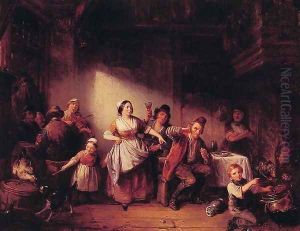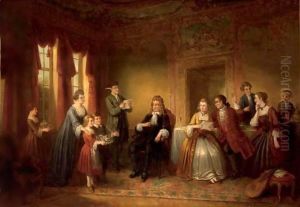Henrich Engelbert Reyntjens Paintings
Henrich Engelbert Reyntjens was a notable Belgian artist born in 1773 in Bruges, a city known for its rich history in the arts. Throughout his life, Reyntjens made significant contributions to the world of painting, particularly in the genres of portraits and historical scenes. His work reflects the artistic transitions of his time, showcasing elements of both the late Baroque period and the emerging Romanticism, thus highlighting his versatility and adaptability as an artist. Reyntjens received his initial training in art in his hometown of Bruges before continuing his studies in Paris. This period was crucial for his development, as it exposed him to the works of contemporary French artists and the classical masters, which would influence his style and technique profoundly. Upon returning to Belgium, Reyntjens embarked on a prolific career, gaining acclaim for his ability to capture the essence of his subjects with a keen eye for detail and a delicate handling of light and shadow. Despite the changing artistic trends of his time, he remained committed to his unique vision, blending traditional techniques with his own innovative approaches to composition and color. Throughout his career, Reyntjens enjoyed the patronage of the Belgian aristocracy and the church, which commissioned him to create portraits and religious artworks. His portraits, in particular, are celebrated for their psychological depth and the dignified portrayal of his subjects. In addition to his commissioned works, Reyntjens also explored historical and mythological themes, which allowed him to express his creative ambitions more freely. His historical paintings are noted for their dramatic intensity and attention to historical accuracy, reflecting his deep interest in European history and culture. Henrich Engelbert Reyntjens passed away in 1855, leaving behind a legacy that has been somewhat overshadowed by his contemporaries. Despite this, his work offers valuable insights into the artistic and cultural shifts of his time. Today, Reyntjens is remembered as a skilled painter whose body of work encapsulates the transition from the classical to the romantic, making him a significant figure in the history of Belgian art.

